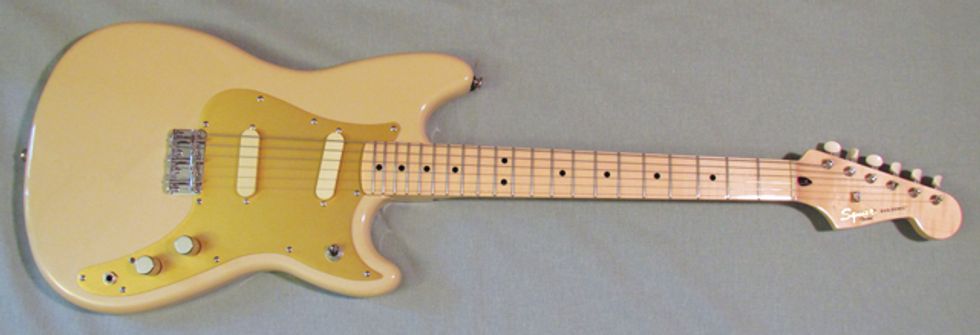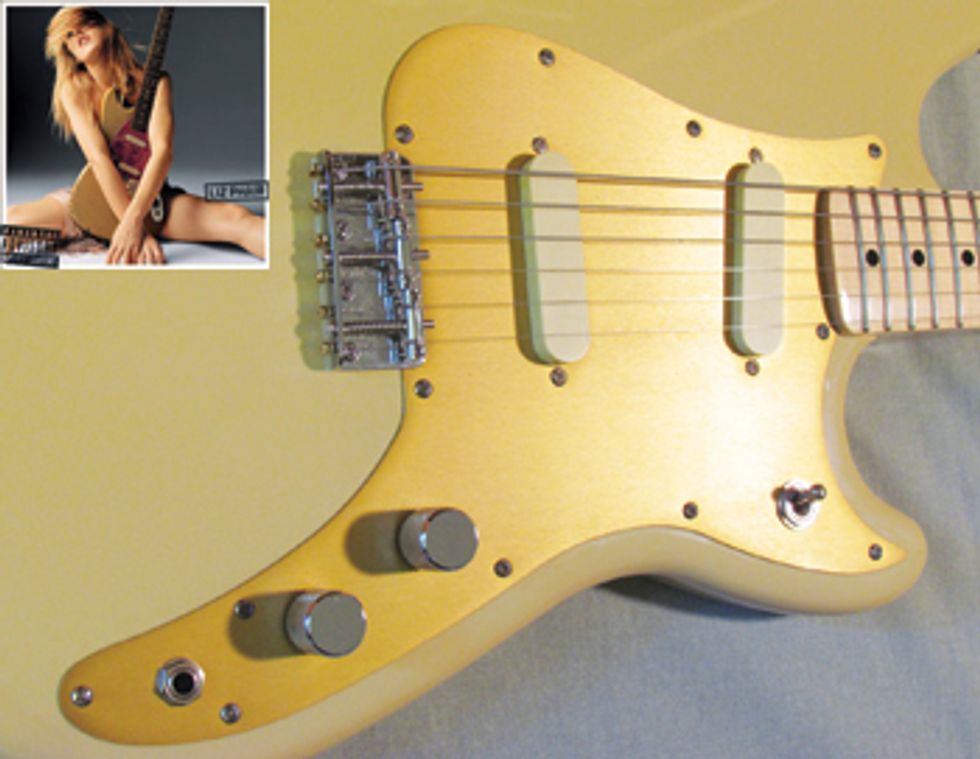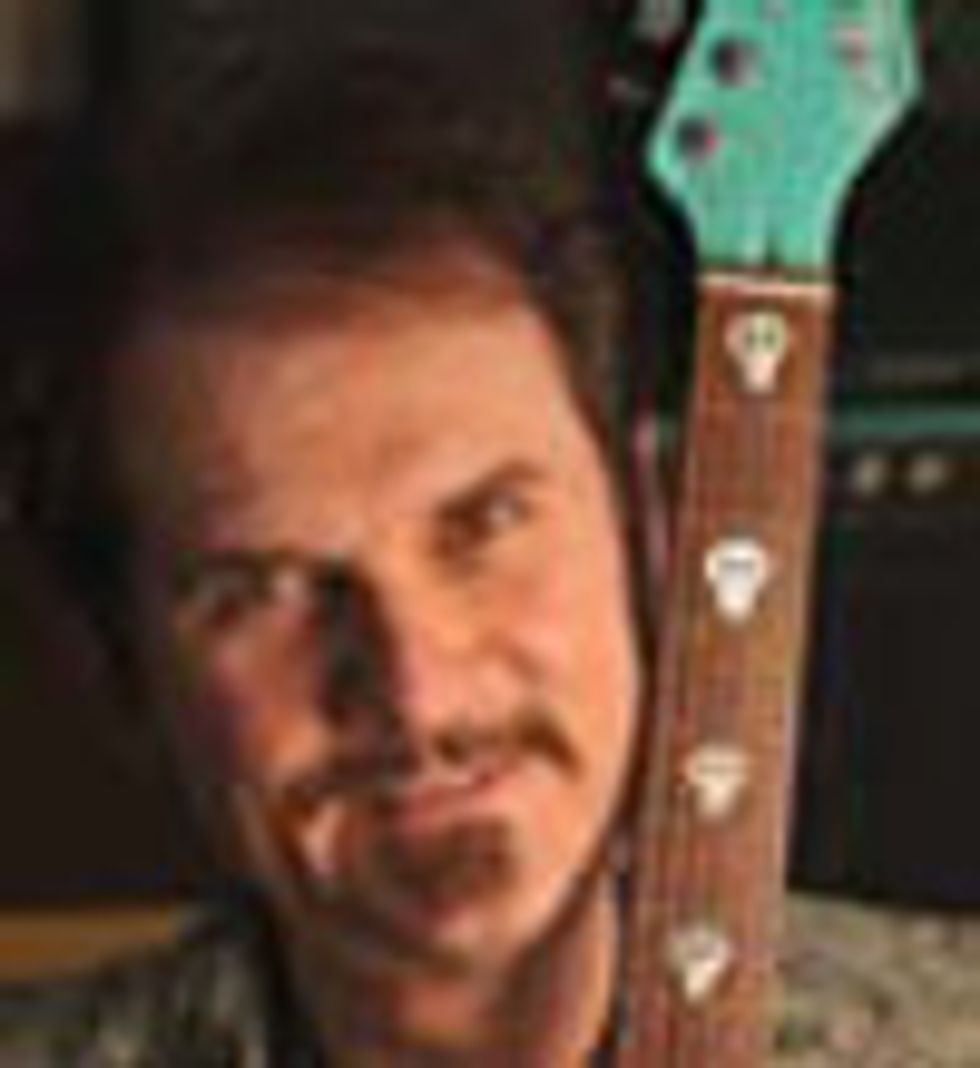
The no-nonsense Classic Vibe Duo-Sonic.
In my younger days, I had a sweet late-’50s Fender Duo-Sonic, and recently—in an effort to try to buy back every model of guitar I sold in my youthful folly—I decided I needed this baby once again. So it was off to eBay to see what was available. The older Duo- Sonics seemed pretty pricey, but it turns out Fender offers a Duo-Sonic as one of the models in its Squier Classic Vibe series. All right! I was on it.
Fender puts more attention to detail into its Classic Vibe models than its typical Squiers, and as a result the Vibes cost a little more. These Duo-Sonics are closely based on the old ’50s model and sport a 24"-scale maple neck, a gold anodized aluminum pickguard, and an appealing Desert Sand finish.
When I started my search, these new Duo-Sonics had a list price of $529, and Musician’s Friend was selling them for $329, so that gave me a starting point on eBay. I found very few preowned models around the ’Bay, but after several weeks of bottom feeding, I finally found a nice used one for $220, plus $25 shipping.

When you catch the light just so, it’s hard to top a gold anodized aluminum pickguard. Note the 3-saddle bridge and “top loader” stringing system. INSET: Posing with a Duo-Sonic on her 2003 self-titled album, Liz Phair has long been associated with this short-scale Fender. Other players known to embrace the model—though perhaps not quite as evocatively—include Jimi Hendrix in his “Jimmy James” Isley Brothers days, Johnny Winter in the late ’60s, Sonic Youth’s Thurston Moore, and Television’s Tom Verlaine and Richard Lloyd.
It may have been listed as used, but when the Duo-Sonic arrived it looked brand-spanking new, as if the original owner unpacked it, strummed a few chords and then stuck it under his bed. I was knocked out by the looks—the paint and the gold pickguard together were very classy! Sporting medium jumbo frets, the shorter-scale maple fretboard—1 1/2" shorter than a Strat or Tele—makes bending pretty easy. Normally I’m more of a rosewood fretboard guy, but in recent years I’ve been warming up to maple ’boards. I also dig the 3-way Telecaster-style barrel saddles. It’s easy for a Tele player to make the transition here.
So how do I like it? I only have two complaints about these new Duo-Sonics: The single-coil pickups are a little weenie-sounding compared to, say, a Tele or a Strat. Why not use standard Strat pickups to make it compete with other guitars in volume? And I’m still trying to like maple fretboards, but the heavy gloss that’s usually applied on them seems to slow down my playing when my fingers get sweaty. I think leaving the gloss off would make these a little more retro and easy on the fingers.
That said, I’m quite pleased That said, I’m quite pleased overall with my Duo-Sonic and will probably keep it. But you know how that goes.
 Will Ray
is a founding
member of the
Hellecasters guitar-twang
trio. He also does guitar
clinics promoting his
namesake G&L signature
model 6-string, and produces
artists and bands at his studio in
Asheville, North Carolina. You can contact
Will on Facebook and at willray.biz.
Will Ray
is a founding
member of the
Hellecasters guitar-twang
trio. He also does guitar
clinics promoting his
namesake G&L signature
model 6-string, and produces
artists and bands at his studio in
Asheville, North Carolina. You can contact
Will on Facebook and at willray.biz.






![Rig Rundown: Russian Circles’ Mike Sullivan [2025]](https://www.premierguitar.com/media-library/youtube.jpg?id=62303631&width=1245&height=700&quality=70&coordinates=0%2C0%2C0%2C0)


























